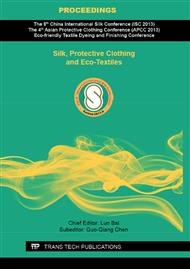p.353
p.360
p.364
p.370
p.374
p.380
p.385
p.390
p.395
Fabrication of Antibacterial and UV Protective Silk Fabrics via in Situ Generating ZnO Nanoparticles by Hyperbranched Polymer
Abstract:
This paper presents a method of fabricating ZnO nanoparticles coated silk fabrics via a one-step in situ generation and deposition reaction. In this procedure, amino terminated hyperbranched polymer (HBP-NH2) and zinc nitrate were used as the precursors without any other binders. The results indicated that UV protective properties and antibacterial activities of treated silk fabrics grew in quantity with increase of the concentration of precursors in this reaction process. When the concentration of HBP-NH2 and zinc nitrate were 24 g/L and 17.85g/L respectively, the UPF value of treated silk fabric was 131 and the bacterial reduction rates against Staphylococcus aureus and Escherichia coli both exceeded 99%. Moreover, the treated silk fabrics were characterized by FESEM, EDS and XRD which demonstrated that the ZnO nanoparticles coated on the silk fibers successfully and well dispersed with diameter around 90nm.
Info:
Periodical:
Pages:
374-379
Citation:
Online since:
September 2013
Authors:
Keywords:
Price:
Сopyright:
© 2013 Trans Tech Publications Ltd. All Rights Reserved
Share:
Citation:


